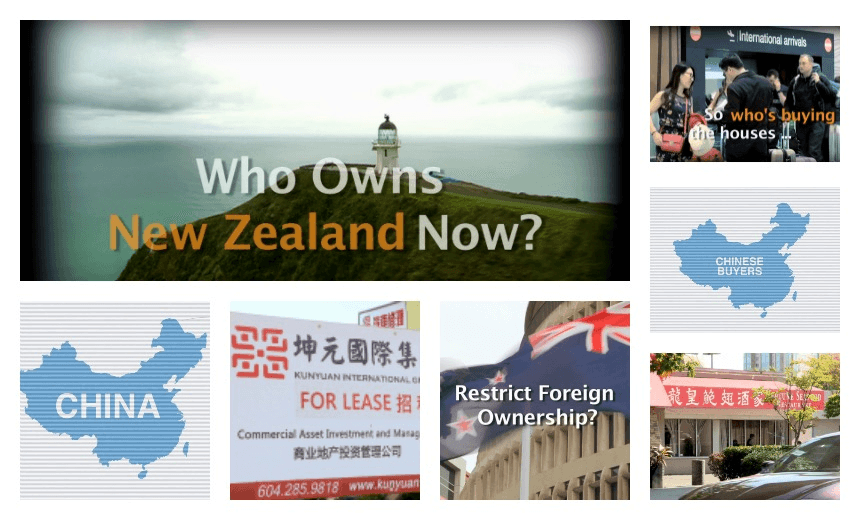Bryan Bruce’s documentary Who owns New Zealand now? – which screened on Three last night in primetime – is a deeply problematic sequel to Labour’s ‘Chinese-sounding names’ fiasco of 2015, writes Duncan Greive.
“There’s been about a trillion dollars that has left China in the last year or so,” intones the voice-over ominously, over flowing strings while spreadsheets merge with images of Auckland. We see images of hànzì characters flash up in cutaways to real estate signs, to bank signs, to shopping districts. There’s talk of “Chinese investors”, “trade missions to China”, “Chinese buyers”, “multi-millionaires” from China.
All in service to a question: Who owns New Zealand now? The hour-long documentary, which screened on Three last night, positions itself as a sober attempt to find an answer, to have a “grown-up” conversation about our housing crisis.
This is clearly a laudable goal, and one which many journalists have been grappling with these past few years: The Nation’s reporting on families living in cars; The Hui on the work of Te Puea marae; The Spinoff’s own Unsettled. I could easily go on.
Unfortunately, along with neoliberalism, which functions as origin story, Bruce’s answer to the titular question appears to be China and the Chinese. This would be tense enough even if he had perfect data, able to prove convincingly that our rampant house price inflation was unequivocally attributable to Chinese capital.
Only, as Bruce rightly points out, our data collection has long been awful. One of this government’s many failings on housing has been a stunning lack of curiosity – we know far too little about what has been driving the precipitous inflation of house prices. Yet, absent knowledge, Bruce persistently infers that it is speculative Chinese money. This makes Who owns New Zealand now? functionally a deeply unpleasant echo of Labour’s ‘Chinese-sounding names’ fiasco of 2015 (a wound which remains open for many Chinese New Zealanders).
In terms of format, the hour-long documentary hews very closely to its predecessor, World Class? Inside NZ Education – A Special Report (they were funded as a pair way back in 2012). That is, it starts off with a depiction of New Zealand as an idyll, where Bruce’s parents could build, and he could buy a house with a government-backed mortgage for twice their annual salary.
There’s old-timey fiddle music and sepia-toned images. Then: disaster! Reagan and Thatcher and Douglas and neoliberalism.
This history lesson is not without merit – it’s very useful for people to know just how much easier it was to buy into housing for prior generations. But the framing of this era as an idyll is inescapably a Pākehā one: he talks about the descent from a home-ownership rate of 74% then to 64% today, without ever acknowledging that at the same peak the rate was under 60% for Māori and under 50% for Pacific people (those too have crashed since). Which is to say that like so many good-old-days narratives, there is no acknowledgement that the old days were particularly good for a specific type of person.
The fixation on neoliberalism is hardly unique to Bruce, but it does seem a form of stylistic throat-clearing. It helps cement the point that this is ultimately an intensely Winstonian world view: pining for days of statist central control and viewing China and the Chinese with deep suspicion.
Having relived the ‘80s we head off overseas, again as we did with his education doc last year – it does look a fun format to make. There’s Ireland, where we see the after effects of a construction boom – plummeting prices, an odd thing to fret about in this context. There’s Turin, where we visit a leafy apartment building where units go for NZ$1m plus – but they had to wait three years for resource consent (I’m not sure what the point is either).
Mostly, there’s Canada. That’s where we meet the guy talking about a trillion Chinese dollars at the start – an associate professor at the mid-ranking Simon Fraser University. After this mission, Bruce feels confident enough to issue a verdict.
“There is that sense in New Zealand that we don’t want to upset the Chinese – and that talking about Chinese money raises racial issues.”
Quite. That is why Labour were so castigated for it a couple of years back. Yet it’s the most persistent thread throughout the documentary, and overwhelms what is worthwhile about it – most notably its segment on rental protection and communal flat ownership in Germany. Instead of a greater focus on international solutions to our housing crisis – one bedevilling many big cities – we linger on unsubstantiated race-baiting and Bruce family history.
That self-involvement is understandable. Who owns New Zealand now? was written, directed, produced and line-edited by one man: Bryan Bruce – whose production company Red Sky has been NZ on Air-funded 18 times in 18 years, totalling just shy of $4.5m.
Amongst those have been titles of merit and importance – but this is not amongst them. Instead it’s an indulgent, cheaply-assembled and -presented travelogue with through lines of old-fashioned nostalgia and scaremongering.
It should not have been made.
